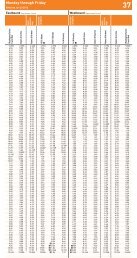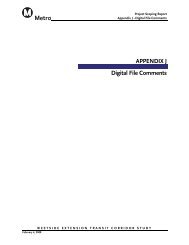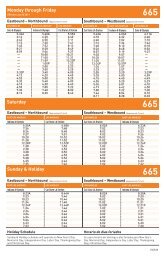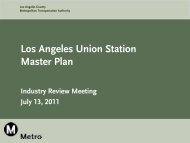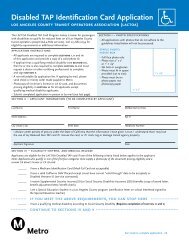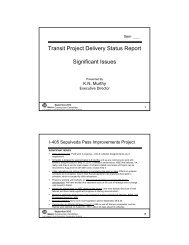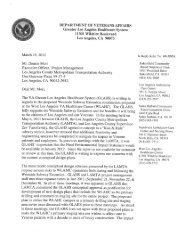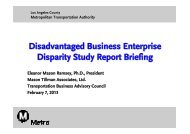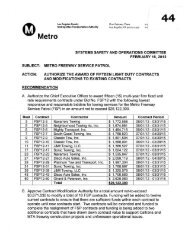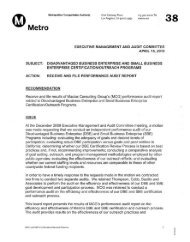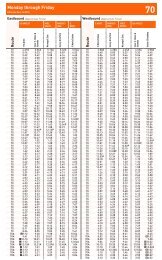Sepulveda Pass Corridor Board Report - Metropolitan ...
Sepulveda Pass Corridor Board Report - Metropolitan ...
Sepulveda Pass Corridor Board Report - Metropolitan ...
Create successful ePaper yourself
Turn your PDF publications into a flip-book with our unique Google optimized e-Paper software.
the MTA's I-110 and I-10 ExpressLanes Project plus finro direct access<br />
connectors (one in the San Fernando Valley and one on the Westside)<br />
rough order of magnitude costs fora 10 mile project between the US-101<br />
Freeway and just north of the I-10 Freeway are estimated to range from<br />
$1.1 billion to $1.2 billion ($2012). In addition to auto traffic, transit buses<br />
would be able to travel in these lanes thereby significantly reducing transit<br />
travel times.<br />
o Highway Tunnels — A large-bore highway tunnel could be constructed<br />
under the <strong>Sepulveda</strong> <strong>Pass</strong>. A recommended distance for an initial project<br />
would be approximately nine miles and would extend from the US-101<br />
Freeway to a location just north of the I-10 Freeway. An example of such<br />
a large-bore tunnel currently in construction in North America is the<br />
Seattle Alaska Highway Replacement Tunnel which is 1.8 miles in length<br />
and carries 4-lanes of traffic (two lanes in each direction). Costs for that<br />
project as reported by the Washington State Department of Transportation<br />
are $2.034 billion ($2013-YOE). Rough order of magnitude costs for a<br />
similar type of project under the <strong>Sepulveda</strong> <strong>Pass</strong> including necessary<br />
surface roadway improvements north and south of the <strong>Pass</strong> are estimated<br />
to range from $10-$13 billion ($2012). In addition to auto traffic, transit<br />
buses would be able to travel in these lanes thereby significantly reducing<br />
transit travel times.<br />
o Rail Tunnels —Twin bore tunnels extending to the Metro Purple Line<br />
(Heavy Rail) or the Metro Expo Line (Light Rail) to the San Fernando<br />
Valley would be possible under the <strong>Sepulveda</strong> <strong>Pass</strong>. A recommended<br />
distance for an initial project would be approximately 10 miles and would<br />
extend from the Metro Orange Line in the San Fernando Valley to the<br />
Metro Expo Line in the Westside. Based on costs for the Westside Purple<br />
Line Extension, rough order of magnitude costs for a rail tunnel under the<br />
<strong>Sepulveda</strong> <strong>Pass</strong> would range from $5-$6 billion ($2012).<br />
Public-Private Partnership Delivery<br />
A major multimodal project consisting of tunnels) under the mountains for highway and<br />
transit could likely only be delivered, within the constraints of currently available funding,<br />
through a comprehensive public-private concession, wherein a privately operated transit<br />
system and multi-lane toll road would have the potential to raise sufficient revenue<br />
through fares and tolls so that the project could be constructed and operated with<br />
minimum public funding. Partnering with a Developer in a PDA approach to project<br />
delivery provides the opportunity for (VITA to concurrently undertake environmental<br />
clearance efforts while the project is developed, significantly accelerating the timing of<br />
delivery. The PDA approach facilitates early contractor involvement, allowing the<br />
Developer to assist in determining the project's technical and financial feasibility,<br />
identifying project risks and mitigations, providing support and input to the<br />
environmental process, while the environmental clearance work is simultaneously, but<br />
<strong>Sepulveda</strong> <strong>Pass</strong> Systems Planning Study



